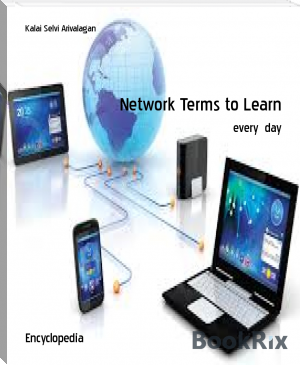Network Terms to Learn - Kalai Selvi Arivalagan (best love novels of all time .TXT) 📗

- Author: Kalai Selvi Arivalagan
Book online «Network Terms to Learn - Kalai Selvi Arivalagan (best love novels of all time .TXT) 📗». Author Kalai Selvi Arivalagan
Labeled Data
Labeled data is a designation for pieces of data that have been tagged with one or more labels identifying certain properties or characteristics, or classifications or contained objects. Labels make that data specifically useful in certain types of machine learning known as supervised machine learning setups.
Analytics of Things
Analytics of Things is the term used to describe the analysis of the data generated by the Internet of Things devices. In other words, analytics of the Internet of Things is Analytics of Things. Analytics of Things is required so as to make the connected devices smart and to give the devices the ability to make intelligent decisions.
Automatic Repeat reQuest (ARQ)
Automatic Repeat ReQuest (ARQ), also called Automatic Repeat Query, is an error-control protocol that automatically initiates a call to retransmit any data packet or frame after receiving flawed or incorrect data. When the transmitting device fails to receive an acknowledgement signal to confirm the data has been received, it usually retransmits the data after a predefined timeout and repeats the process a predetermined number of times until the transmitting device receives the acknowledgement. ARQs are often used to assure reliable transmissions over an unreliable service.
AWS Elastic Beanstalk
AWS Elastic Beanstalk is an application deployment tool that helps developers to deploy applications on AWS. This service helps make application deployment quicker and more efficient, and it takes a lot of the guesswork out of deploying applications in the AWS environment.
Deterministic Finite Automaton
A deterministic finite automaton is a type of deterministic algorithm based on a state that changes with inputs. These are also known as deterministic finite state machines or deterministic finite acceptors.They are different from probabilistic and non-deterministic models in that one input (X) results in one known output (Y).
Boolean Logic
Boolean logic is a type of computer science originally developed by mathematician George Boole in the mid-1800s. It supports a great deal of algorithmic programming and the emergence of computing functionality approaching artificial intelligence (AI).
Sandbox
A sandbox is a style of game in which minimal character limitations are placed on the gamer, allowing the gamer to roam and change a virtual world at will. In contrast to a progression-style game, a sandbox game emphasizes roaming and allows a gamer to select tasks. Instead of featuring segmented areas or numbered levels, a sandbox game usually occurs in a "world" to which the gamer has full access from start to finish. A sandbox game is also known as an open-world or free-roaming game.
Neuro Symbolic Artificial Intelligence
Neuro Symbolic Artificial Intelligence, also known as neurosymbolic AI, is an advanced version of artificial intelligence (AI) that improves how a neural network arrives at a decision by adding classical rules-based (symbolic) AI to the process. This hybrid approach requires less training data and makes it possible for humans to track how AI programming made a decision.
In image recognition, for example, Neuro Symbolic AI can use deep learning to identify a stand-alone object and then add a layer of information about the object’s properties and distinct parts by applying symbolic reasoning. This way, a Neuro Symbolic AI system is not only able to identify an object, for example, an apple, but also to explain why it detects an apple, by offering a list of the apple’s unique characteristics and properties as an explanation.
Neuro Symbolic AI is expected to help reduce machine bias by making the decision-making process a learning model goes through more transparent and explainable. Combining learning with rules-based logic is also expected to help data scientists and machine learning engineers train algorithms with less data by using neural networks to create the knowledge base that an expert system and symbolic AI requires.
Term of the day - 25Copy Data Virtualization
Copy data virtualization is a type of virtualization approach applied to copies of data used for backup or archiving. With data backup and management looming so large in the business IT world, copy data virtualization is an attempt to make use of this data more efficiently.
Data Center Capacity Planning
Data center capacity planning is the process of planning for current and future hardware, software and other data center infrastructure requirements within a perceived time frame. It is a form of IT capacity planning that reviews and analyzes current data center utilization in order to plan ahead for data center capacity increment, decrement, both or none.
Human Augmentation
Human augmentation is generally used to refer to technologies that enhance human productivity or capability, or that somehow add to the human body. Modern advancements in many areas of IT have led to a greater variety of implants and other technologies that could be classed as human augmentation. Human augmentation may also be called human 2.0.
Intelligent Matching
Intelligent matching is a type of data management technique in which data is searched, indexed and retrieved from a database through a series of artificial-intelligence-based data sorting and matching algorithms. Intelligent matching makes it possible to find data based on the principles of semantics, where human-like searching and inference techniques are applied to each query.
Quantum as a Service (QaaS)
Quantum as a service (QaaS) is a term for services that bring the functionality of quantum computing to clients through cloud delivery processes. This is part of a range of services based on the broader software as a service (SaaS) model.
Adaptive Resonance Theory (ART)
Adaptive resonance theory (ART) is a particular philosophy driving unsupervised artificial neural network models. It uses a specific architecture, often useful in some types of neural networks, to try to build the capacity for new learning while keeping in place fundamental existing models.
Endpoint Detection and Response (EDR)
Endpoint detection and response (EDR) is a specific type of security focusing on endpoint devices. It is often described as the use of a central data repository to observe and analyze endpoint vulnerabilities and work toward stronger endpoint threat response.
Big Data Architecture
Big data architecture is the logical and/or physical layout/structure of how big data is stored, accessed and managed within a big data or IT environment. It logically defines how the big data solution will work, the core components (hardware, database, software, storage) used, flow of information, security and more.
Chief Cloud Officer
A chief cloud officer (CCO) is an individual who manages, supervises and governs the entire cloud computing environment and its operations within an organization. The chief cloud officer allows an organization to harness the power, productivity and efficiency from a suite of cloud computing solutions and services. As such, the CCO is the ultimate custodian of cloud-related resources and components.
Attack Surface
The attack surface of a system is the complete set of vulnerabilities that exist within that system. It is a metaphor used for assessing security in a hardware and software system. The attack surface is not an actual surface, but it helps the individual to visualize where vulnerabilities are in a system.
Technical Errata
Technical errata is a collection of faults or errors for any hardware or software system. It is a technical term for various types of research that uncover the shortcomings of a particular architecture.
Tunnel Broker
In networking, a tunnel broker is the service entity that provides a tunneling capacity between networks. Individual tunnel brokers are chosen to help route protected data through a network tunnel for security or privacy, or other purposes.
Mimikatz
Mimikatz is an open-source application that allows users to manipulate authentication credentials in Windows systems. Created to work as a proof of concept tool for Windows security, Mimikatz has been used by hackers to compromise many different types of systems.
Data Sandbox
A data sandbox includes massive parallel central processing units, high-end memory, high-capacity storage and I/O capacity and typically separates data experimentation and production database environments in data warehouses. The IBM Netezza 1000 is an example of a data sandbox platform which is a stand-alone analytic data mart. An example of a logical partition in an enterprise data warehouse, which also serves as a data sandbox platform, is the IBM Smart Analytics System. A Hadoop cluster like IBM InfoSphere BigInsights Enterprise Edition is also included in this category. This definition was written in the context of Big Data.
Chief Knowledge Officer (CKO)
A chief knowledge officer (CKO) is a corporate title for a professional within an organization who oversees its knowledge management. Not all businesses have CKO roles, but many larger companies have carved out this position in order to benefit from a more proactive use of data and other knowledge resources, which can be used to gain competitive advantage and improve overall organizational performance.
Application Analyst
An application analyst is a professional who supports a particular application or set of applications. This can involve some types of computing and design or maintenance work, as well as facilitating particular use cases. An application analyst is also known as an application support analyst.
Feedforward Neural Network
The feedforward neural network is a specific type of early artificial neural network known for its simplicity of design. The feedforward neural network has an input layer, hidden layers and an output layer. Information always travels in one direction – from the input layer to the output layer – and never goes backward.
Business Process as a Service (BPaaS)
Business process as a service (BPaaS) is a term for a specific kind of web-delivered or cloud hosting service that benefits an enterprise by assisting with business objectives. In the general sense, a business process is simply a task that must be completed to benefit business operations. Using the term BPaaS implies that the business process is being automated through a remote delivery model.
Bluesnarfing
Bluesnarfing is a device hack performed when a wireless, Bluetooth-enabled device is in discoverable mode. Bluesnarfing allows hackers to remotely access Bluetooth device data, such as a user's calendar, contact list, emails and text messages. This attack is perpetrated without the victim's knowledge.
Cloud Cartography
Cloud cartography refers to figuring out the physical locations of hardware installations used by cloud computing service providers. Mapping a service provider’s hardware can help identify the most likely locations for a virtual machine, or help viewers to generally
understand where the service provider deploys hardware.
Hashing
Hashing is generating a value or values from a string of text using a mathematical function. Hashing is one way to enable security during the process of message transmission when the message is intended for a particular recipient only. A formula generates the hash, which helps to protect the security of the transmission against tampering. Hashing is also a method of sorting key values in a database table in an efficient manner.
Rational Agent
In machine learning and artificial intelligence research, the “rational agent” is a concept that guides the use of game theory and decision theory in applying artificial intelligence to various real-world scenarios. The rational agent is a theoretical entity based on a realistic model, that has preferences for advantageous outcomes, and will seek to achieve them in a learning scenario.
Operating System Virtualization (OS Virtualization)
Operating system virtualization (OS virtualization) is a server virtualization technology that involves tailoring a standard operating system so that it can run different applications handled by multiple users on a single computer at a time. The operating systems do not interfere with each other even though they are on the same computer. In OS virtualization, the operating system is altered so that it operates like several different, individual systems. The virtualized environment accepts commands from different users running different applications on the same machine. The users and their requests are handled separately by the virtualized operating system. Also known as





Comments (0)